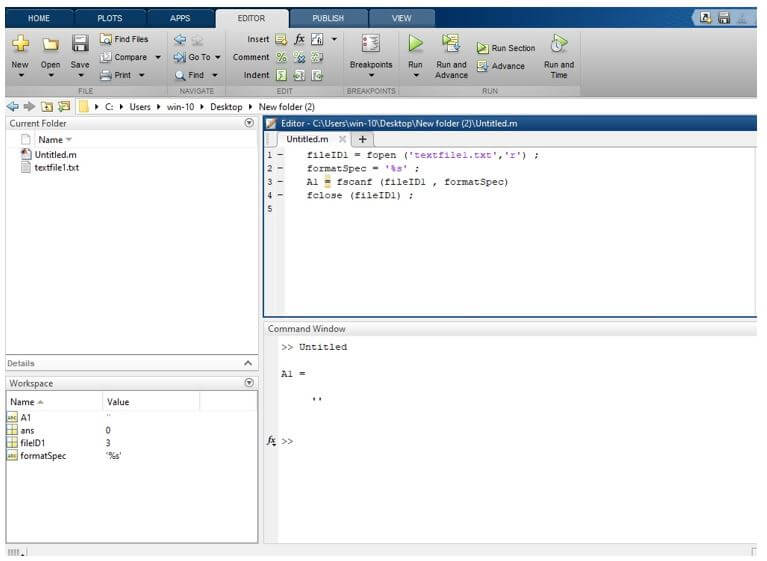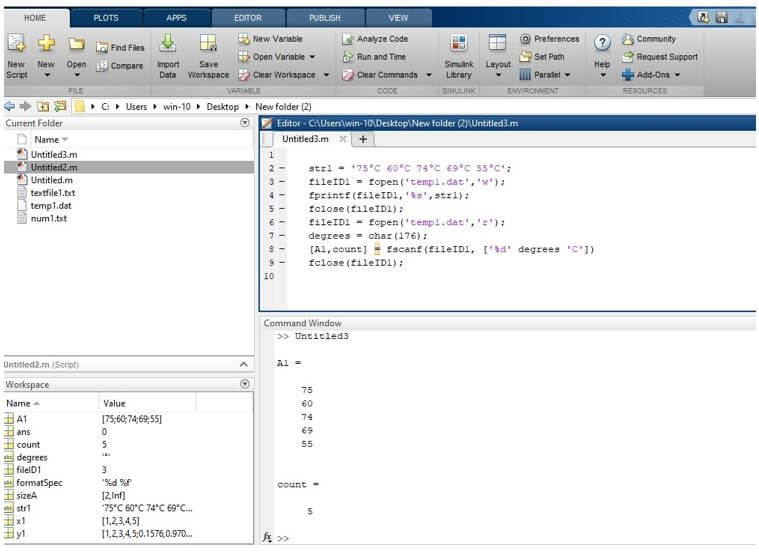Matlab Fscanf How to Read Serial Port

Introduction to fscanf Matlab
There is a demand to admission the text file in some application to exercise operations like data reading from a text file, data writing on a text file. For reading information from a text file, we utilize a fscanf argument. fscanf is an inbuilt function available on MatLab for reading information from a text file ( .txt extension). For reading data, firstly, we must demand to open up that file using a fopen statement, and nosotros specify the type of admission mode to reading 'r'.
Syntax:
The syntax for fscanf Matlab is as shown below:
A = fscanf (fileID,formatSpec)
A = fscanf (fileID,formatSpec,sizeA)
[A,count] = fscanf (_)
How to exercise Matlab fscanf?
For reading data from a text file, nosotros employ a fscanf statement. For to open that file using a fopen statement. In the fopen argument, nosotros write a text file proper name which nosotros want to open up and specify a type of admission mode.
The steps for reading a text file using a fscanf statement:
- Stride i: Commencement, open a file using fopen statement and specify the type of access mode.
- Step 2: Specify the formats specifies and, if needed, so sizeA.
- Step 3: Then, nosotros use a fscanf statement and brandish the read data.
- Step four: Close the file using fclose statement.
Examples of fscanf Matlab
Given beneath are the examples of fscanf Matlab:
Example #one
Let us see the example for reading operation; for reading operation, we take a text file textfile1.txt, for a reading performance firstly, we specify the type of access for that we use a fopen statement, we take fopen in parenthesis, we take the text file proper name which we want to read (filetext1.txt) and the type of admission that is reading the file which is specified by 'r', and a comma separates these two arguments. Then specify the format using 'formatspec' we defined as a float. Then we use the fscanf statement; basically, it is used for reading a text file. We take fscanf in parenthesis we write a fileID1 (text file is indicated by file identifier fileID1) and format specifier, which nosotros defined before that is formatSpec and these ii arguments are separated by a comma. This read information stored in variable A1. And we shut the file using fclose argument.
Lawmaking:
fileID1 = fopen ('textfile1.txt','r') ;
formatSpec = '%south' ;
A1 = fscanf (fileID1 , formatSpec)
fclose (fileID1) ;
Output:

Example #two
Let us consider another example; in this instance, we take an integer number as we equally float numbers, integer numbers are stored in x1 variable, and floating numbers are created past using a rand role (rand function returns a random float number) and these float numbers are stored in y1 variable. Then we open a file using a fopen statement, then we write these numbers using a fprintf statement, so we close the file using a fclose statement. And so we see that data using a type function; the type function is used to brandish the data of contents. Then we open a file once more using a fopen statement, and we specify the blazon of admission mode in reading 'r', and then we assign that fopen return data to fileID1; fileID1 is a file identifier of an open file. And then nosotros specify the format on a format specifier ( formatSpec), and so a sizeA, sizeA must be a positive integer. Then we take a fscanf statement, in fscanf in a parenthesis, have a file identifier (fileID1), format specifier (formatSpec) and a sizeA and the render read data are stored in the A1 variable. Then we need to shut that opened file using a fclose statement. Then we just transpose the A1 using a transpose symbol. So we see a consequence on the control window.
Code:
x1 = 1:1:5;
y1 = [x1;rand(i,v)];
fileID1 =fopen('num1.txt','w');
fprintf(fileID1,'%d %4.4f\n',y1);
fclose(fileID1);
type num1.txt
fileID1 = fopen('num1.txt','r');
formatSpec = '%d %f';
sizeA = [2 Inf];
A1 = fscanf(fileID1,formatSpec,sizeA)
fclose(fileID1);
A1 = A1'
Output:

Example #iii
Allow us come across an example related to the fscanf statement; in this instance, we skip the text that is °C text in a string. We accept i temperature string on a variable str1. We open a temp1.txt file using a fopen statement and specify the type of access mode to write, and these fopen statements assign to file identifier fileID1. Then we write that temperature string on a temp1.txt file using a fprintf argument. And so we close that opened file using a fclose statement. Then we again open that file for reading using the fopen statement; in fopen, we specify the blazon of access mode to read 'r', then information technology assigns to file identifier fileID1. The ASCII code of °C is 176; these are passed to degrees variable. Then we take a fscanf statement; in fscanf, we have the file identifier of an open file, and in square brackets, we accept an integer number of degrees that is nothing just °C, these information are assigned to A1 and count. A1 is a temperature and in count stores a number of °C. Then we simply shut that opened file using a fclose argument.
Code:
str1 = '75°C threescore°C 74°C 69°C 55°C';
fileID1 = fopen('temp1.dat','west');
fprintf(fileID1,'%s',str1);
fclose(fileID1);
fileID1 = fopen('temp1.dat','r');
degrees = char(176);
[A1,count] = fscanf(fileID1, ['%d' degrees 'C'])
fclose(fileID1);
Output:

Conclusion
In this article, we saw the concept of fscanf; basically, fscanf is used for reading data from a text file. Then saw syntax related to fscanf statements and how it'due south used in MatLab lawmaking. Besides, nosotros saw some examples related to fscanf statement.
Recommended Articles
This is a guide to fscanf Matlab. Here nosotros hash out the introduction, how to do Matlab fscanf? Along with examples, respectively. You may too have a await at the following articles to acquire more –
- Matlab plot championship
- Matlab Stacked Bar
- Matlab Sort
- Bandpass Filter Matlab
Source: https://www.educba.com/fscanf-matlab/
0 Response to "Matlab Fscanf How to Read Serial Port"
Post a Comment